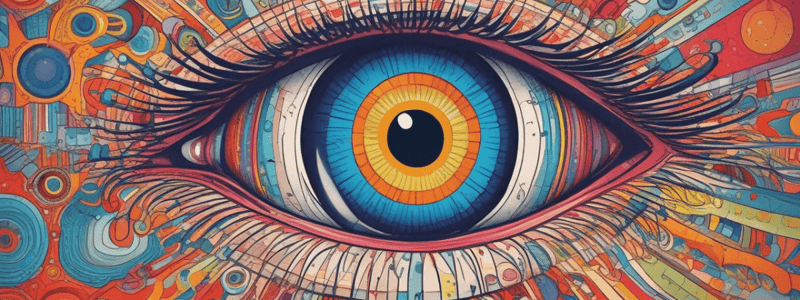Podcast
Questions and Answers
What causes changes in the spectrum during light passage through matter?
What causes changes in the spectrum during light passage through matter?
- Scattering (correct)
- Diffraction
- Absorption
- Reflection
What does the hue of a color refer to?
What does the hue of a color refer to?
- The intensity of light from the color
- The dominant wavelength in the spectrum (correct)
- The range of wavelengths subtracted from white light
- The amount of white in the spectrum
Which of these is an example of a non-spectral color?
Which of these is an example of a non-spectral color?
- Red
- Green
- Blue
- Magenta (correct)
What is a psychophysical description of brightness?
What is a psychophysical description of brightness?
How can color be produced by addition?
How can color be produced by addition?
What characterizes desaturated colors?
What characterizes desaturated colors?
What is the primary cause of colour blindness?
What is the primary cause of colour blindness?
Why is the overlap of sensitivity curves crucial for colour vision?
Why is the overlap of sensitivity curves crucial for colour vision?
What happens when all three cone types are equally stimulated?
What happens when all three cone types are equally stimulated?
How do video displays create the illusion of colours?
How do video displays create the illusion of colours?
What effect does the colour of incident light have on perceived object colour?
What effect does the colour of incident light have on perceived object colour?
What is the apparent colour of an apple when illuminated with only blue/cyan light?
What is the apparent colour of an apple when illuminated with only blue/cyan light?
Why might our visual system be fooled into perceiving colours that aren’t really present?
Why might our visual system be fooled into perceiving colours that aren’t really present?
How do objects’ interactions with light contribute to their observed colour?
How do objects’ interactions with light contribute to their observed colour?
Flashcards are hidden until you start studying
Study Notes
Colour Recognition with 3 Cone Types
- Having three cone types with slightly different sensitivity curves allows us to distinguish colours by associating each with a specific set of response rates.
- Overlap of sensitivity curves is crucial for colour vision.
- Colour blindness is caused by the absence or dysfunction of one or more cone types.
- We can be fooled into perceiving colours that aren't really there, and all video displays make use of this kind of illusion.
Colour Perception
- Illumination of the world rarely involves only one wavelength.
- The solar spectrum is roughly "constant" in the visible spectrum.
- Equal stimulus of all three cones produces a "white" sensation.
- Interaction with objects' surfaces changes (filters) the spectrum, making the colour of an object correspond to the set of wavelengths that are NOT absorbed, but are instead reflected/transmitted.
- Object colour is complementary to that which is absorbed.
The Origin of Colour
- Light can interact with matter through reflection, transmission, absorption (often wavelength-dependent), and interference (leading to iridescence).
- The colour of an object corresponds to the set of wavelengths that are NOT absorbed, but are instead reflected/transmitted.
- Examples:
- Apple skin strongly absorbs light in the blue and green bands, but reflects wavelengths in the red band.
- Banana skin strongly absorbs light in the blue band.
Colour Production
- Two ways to produce colour:
- Subtraction of ranges of wavelengths from white light.
- Addition of a few specific wavelengths.
- Changes in spectrum may occur due to scattering of light during passage through matter (e.g., blue sky).
Psychophysical Description of Colour
- Hue: The spectral colour associated with the "dominant" wavelength in the spectrum presented.
- Saturation: The amount of white in a spectrum.
- Brightness: The degree (or intensity) with which light seems to be coming from a colour.
Spectral and Non-Spectral Colours
- Spectral: A sensation that can also be produced by a single wavelength of light.
- Non-Spectral: A sensation that cannot be reproduced using only one wavelength of light.
- Examples:
- Magenta: Simultaneous red and blue stimulus with little/no green.
- Greys: Low-brightness whites.
- Desaturated colours: Containing at least some level of equal stimulus of all cone types.
- The range of human colour perception extends to a much wider palette than just spectral colours.
Studying That Suits You
Use AI to generate personalized quizzes and flashcards to suit your learning preferences.




